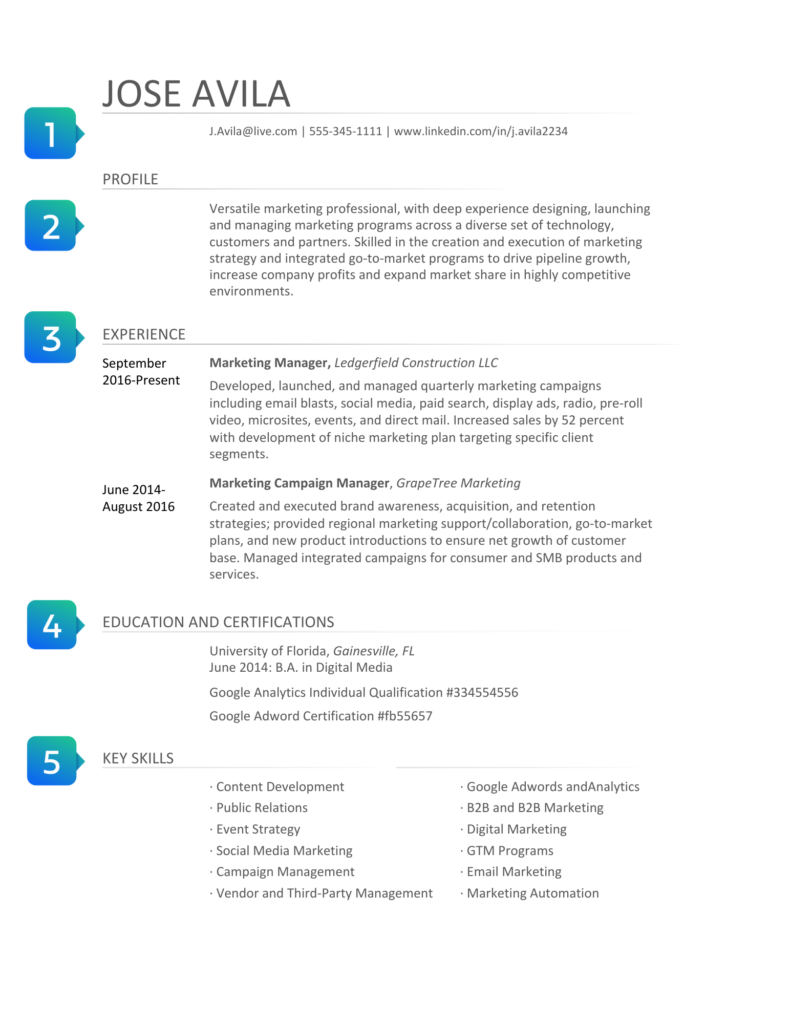What is a chronological resume?
A chronological resume is the most common resume format used by job seekers in the United States. Like the name suggests, your previous jobs are listed by date, in reverse order beginning with the current or most recent position on top.
This type of resume is the most popular option for most people. When using other formats like simple, modern, and combination, the jobs will usually be listed in chronological order too.
Who should use a chronological resume?
- Most job seekers, since this is a safe choice
- People who want to highlight career progression and achievements
- Anyone with an extensive work history
- Job seekers who want to create a resume in text-only format
- People who have a consistent work history or career track
Who shouldn’t use a chronological resume?
- People who lack a clear career progression
- Applicants with limited work history
- Applicants with multiple short-term work situations
- Job seekers who want to create a more graphic and creative resume template
Chronological resume format and key components
While there’s no single resume format that you absolutely must stick to, there is one characteristic all great resumes have in common: they’re easy for someone to scan. The best resume format is one that’s organized and visually manageable, with no large blocks of text or sections crowded too close together.
Here are the main resume components to include if you’re going to use this style:
- Contact information
When you list contact information on your resume you should always include the most up-to-date methods of communication. Things like full name, phone number, and email address are a given, but in our opinion, you may also want to include additional methods such as your Linkedin profile or website. Another point to take note of is that all of the information listed is something you are alright with a hiring manager reviewing such as a professional email address like your name rather than something silly like [email protected]. - Summary or objective
It’s a good idea to start off your resume with a short introductory paragraph. You have some flexibility here, you might want to list your career objectives or list your general accomplishments so that the resume reader will quickly be able to see your goal. It makes sense to have a generic statement that can be used for a variety of jobs, however, you should also try to customize the section when appropriate for the specific position to which you are applying. Even doing something small like mentioning the company you’re applying for will help you stand out among the hundreds of other candidates that you might be competing with.
- Work history
List each position, including your current role in reverse chronological order. Be sure to include the following for each job you worked.
– Full company name
– Date(s) of employment
– Job title
You also should describe your responsibilities in either bullet or paragraph form while making sure to highlight your accomplishments. Depending on your seniority and skills there are a variety of ways to describe and display your job history. - Education and certifications
This section can either be combined or listed separately depending on what is important to emphasize for the position. Key pieces of information here are the school or schools that were attended and the specific degree obtained. For professional certifications, you may need to list an identifying number or date obtained. - Skills
Most job seekers will choose to list skills as an opportunity to summarize their strengths and abilities. Make sure that you are listing only the most relevant and important attributes pertaining to your career path. Depending on the profession, you may want to emphasize technical over soft skills or vice versa.
Need help crafting a resume?
Build the perfect chronological resume today, and get hired faster!
